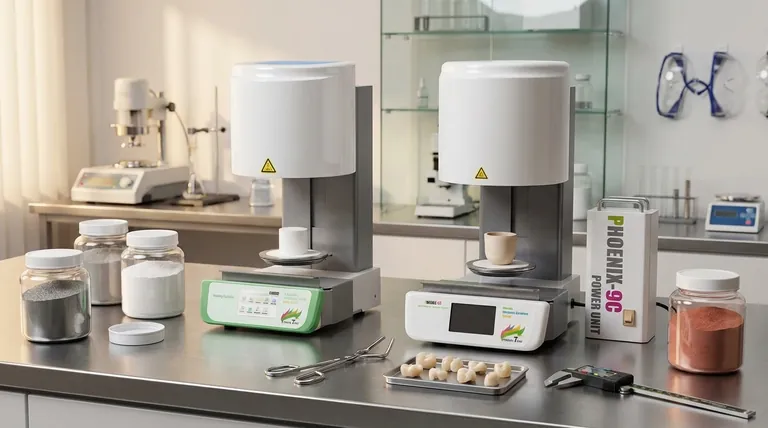To put it simply, sintering works with a vast range of materials, primarily categorized as metals and ceramics. The process can be applied to nearly any material that is available in a powdered form, including common metals like stainless steel, aluminum, and titanium alloys, as well as advanced ceramics such as aluminum oxide and zirconia.
The critical insight is that sintering is not about melting a material, but about using heat and pressure to fuse individual particles together. This is why it is so versatile, allowing for the creation of solid parts from materials with extremely high melting points or even a blend of different powders.

Why Sintering is So Material-Agnostic
The versatility of sintering comes from its core mechanism, which relies on atomic diffusion rather than bulk melting. This fundamental principle opens the door to a wide array of material choices.
Fusing Below the Melting Point
The process heats a compacted powder to a temperature below its melting point. At this elevated temperature, the atoms at the surface of the particles become highly active.
They begin to diffuse across the boundaries of neighboring particles, creating strong metallic or covalent bonds. This is how a loose powder transforms into a dense, solid mass.
The Universal Starting Point: Powder
Sintering always begins with a powder. This powdered form is the great equalizer, allowing materials with vastly different properties to be processed in a similar way.
The ability to create and compact powders is the main prerequisite for a material to be a candidate for sintering.
The Power of Blending
Because the process starts with powders, different materials can be mixed before compaction. This allows for the creation of unique alloys and composites that would be difficult or impossible to produce through traditional melting and casting.
A Breakdown of Sinterable Materials
While the principle is universal, materials are chosen based on the desired final properties of the component, such as strength, heat resistance, or electrical conductivity.
Metals and Metal Alloys
Metal sintering is widely used to create complex, net-shape parts for automotive, aerospace, and industrial applications.
Common examples include:
- Stainless Steel
- Aluminum
- Nickel
- Copper
- Titanium Alloys
Advanced Ceramics
Ceramics are chosen for their exceptional hardness, high-temperature stability, and wear resistance. Sintering is one of the primary methods for manufacturing ceramic components.
Common examples include:
- Aluminum Oxide (Alumina)
- Zirconium Oxide (Zirconia)
- Silicon Dioxide
- Glass
- Various Metal Oxides (Iron, Magnesium, Beryllium)
Understanding the Key Trade-offs
Choosing a material for sintering involves more than just its composition. The process itself introduces variables that must be managed to achieve the desired outcome.
Inherent Porosity
While the goal is to create a dense part, achieving 100% density can be difficult. Most sintered parts retain a small amount of porosity, which can affect mechanical properties like strength and fatigue life.
Material-Specific Processing
The ideal sintering temperature, pressure, and atmospheric conditions vary significantly between materials. For example, some ceramics have low water affinity and require organic additives to aid in compaction before heating.
Managing Shrinkage
As the particles fuse and the gaps between them close, the overall part shrinks. This densification is a planned part of the process, and the initial mold or digital model must be designed to compensate for this predictable reduction in size.
Difficult-to-Densify Materials
Some materials, particularly nano-ceramics, resist densification under normal conditions. For these, specialized techniques like hot pressing (applying pressure during the heating phase) are required to achieve a solid final part.
Selecting the Right Material for Your Goal
Your choice of material is the single most important factor in determining the final properties of the sintered component.
- If your primary focus is structural strength and complex geometry: Metal powders like stainless steel and titanium alloys are the industry standard for producing robust mechanical parts.
- If your primary focus is extreme heat resistance or hardness: Advanced ceramics like alumina and zirconia offer superior performance in demanding thermal and abrasive environments.
- If your primary focus is a unique set of properties: Leverage the ability to blend different powders to create custom alloys or composites tailored to your specific application.
Ultimately, understanding your material options is the first step toward unlocking the full potential of the sintering process.
Summary Table:
| Material Category | Common Examples | Key Properties |
|---|---|---|
| Metals & Alloys | Stainless Steel, Aluminum, Titanium, Copper, Nickel | High Strength, Good Conductivity, Complex Geometries |
| Advanced Ceramics | Aluminum Oxide (Alumina), Zirconium Oxide (Zirconia) | Extreme Hardness, High-Temperature Stability, Wear Resistance |
| Composites & Blends | Custom mixtures of metal and/or ceramic powders | Tailored properties for specific applications |
Ready to select the perfect material for your sintered component?
KINTEK specializes in providing the lab equipment and consumables needed for advanced sintering processes. Whether you are working with high-performance metals, advanced ceramics, or custom composites, our expertise can help you achieve superior results.
Contact our experts today to discuss your project requirements and discover how KINTEK can support your laboratory's sintering innovation.
Visual Guide

Related Products
- Dental Porcelain Zirconia Sintering Ceramic Furnace Chairside with Transformer
- Vacuum Heat Treat and Molybdenum Wire Sintering Furnace for Vacuum Sintering
- Vacuum Heat Treat and Sintering Furnace with 9MPa Air Pressure
- Spark Plasma Sintering Furnace SPS Furnace
- Small Vacuum Heat Treat and Tungsten Wire Sintering Furnace
People Also Ask
- What is the sintering time for zirconia? A Guide to Precise Firing for Optimal Results
- What is a dental oven? The Precision Furnace for Creating Strong, Aesthetic Dental Restorations
- What is the temperature of sintering zirconia? Mastering the Protocol for Perfect Dental Restorations
- What are the white spots on zirconia after sintering? A Guide to Diagnosing and Preventing Defects
- Can you change the color of zirconia crowns? Understanding the Permanent Nature of Zirconia



















